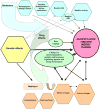Antipsychotic drugs and obesity
- PMID: 21185230
- PMCID: PMC3053585
- DOI: 10.1016/j.molmed.2010.10.010
Antipsychotic drugs and obesity
Abstract
Mechanisms underlying antipsychotic cardiometabolic adverse effects are incompletely understood. This hampers the identification of high-risk patients, low-risk antipsychotics and preventive/ameliorative treatments. Recent clinical, molecular and genetic data suggest that: (i) antipsychotic-naïve samples provide the greatest power for mechanistic studies; (ii) weight and metabolic effects can be discordant, pointing to overlapping and distinct mechanisms; (iii) antipsychotics affect satiety and energy homeostasis signaling; (iv) the specific peptides mediating these effects are unknown but probably overlap with those involved in idiopathic obesity; and (v) single nucleotide polymorphisms in genes encoding known neurotransmitter receptors and metabolic proteins are promising pharmacogenomic targets for countering adverse affects. However, sophisticated molecular studies and genome-wide association studies, ideally in antipsychotic-naïve/first episode samples, are needed to further advance the field.
Copyright © 2010 Elsevier Ltd. All rights reserved.
Figures


References
-
- Gersh BJ, et al. Novel therapeutic concepts: the epidemic of cardiovascular disease in the developing world: global implications. Eur Heart J. 2010;31:642–8. - PubMed
-
- Fleischhacker WW, et al. Comorbid somatic illnesses in patients with severe mental disorders: clinical, policy, and research challenges. J Clin Psychiatry. 2008;69:514–9. - PubMed
-
- De Hert M, et al. Cardiovascular disease and diabetes in people with severe mental illness position statement from the European Psychiatric Association (EPA), supported by the European Association for the Study of Diabetes (EASD) and the European Society of Cardiology (ESC) Eur Psychiatry. 2009;24:412–24. - PubMed
Publication types
MeSH terms
Substances
Grants and funding
LinkOut - more resources
Full Text Sources
Medical

